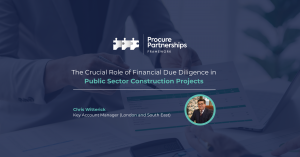Following on from our last Social Value article in August, whereby we discussed ‘The Long-term benefits of Social Value’ the day-to-day conversations and debates with stakeholders has evoked the drive behind this article. The chicken or the egg…to include or not to include Social Value at tender stage, that is the question. Since the launch of the Social Value Model (2020) back in September 2020, there is more awareness around the importance/consideration of Social Value.
Including thoughts and opinions from client’s:
• Steve Everitt | Manchester Metropolitan University | Assistant Director of Procurement
As well as Contractor’s points of view:
• Jack Kidder | Henry Boot | Responsible Business Manager
• Emma Milward | Tilbury Douglas | Regional Marketing Manager
• Phil Eves | BAM | Education Co-ordinator for the Midlands
Tick Box
We hope to quash some of the hearsay and misconceptions when it comes to this ‘nice to have’ in the construction industry, that despite the progression of Social Value, in reality, is still referred to by many as a ‘tick box’ exercise. From clients who ‘haven’t got time’ to include it and Contractors who ‘Don’t have to do it because it wasn’t included in the bid’. We wonder if the point of Social Value is being lost in translation, along with it’s tangible benefits for both Client and Contractor.
As a Social Value Manager for a National Public Sector Procurement Framework, meeting jointly with clients and contractors on a daily basis, the focus on social value continues to differ from client to client, thus having a knock-on effect to the contractors’ overall approach. That said, should the tender documents alone dictate a contractors focus on social value add? A work history including Social Housing, Stakeholder Engagement and social value delivery to Bid Management for an SME Contractor and a Tier One Contractor has given me a bird-eye view of the different approaches and attitudes towards the topic.
It is becoming more and more apparent that Social Value is a phrase known by many, but perhaps understood by few. From a client perspective, with a project in mind-ready to start their journey of procurement, why would the client include social value in their evaluation process, maybe they (the client) procurement lead has heard that it should be included and that it should equate to 10% of the quality weighting…but what is it? Is it going to cost the client money? Who would evaluate the returned responses if it is not understood by the organisation/procurement lead and who is going to have the time to monitor/track the progress of the delivery once on site?
Clients Establishing Key Themes
For projects whereby funding has been sought after, there will have been key themes/objectives set out to acquire the funding. This makes the task of Social Value being incorporated into the tender documents a lot more straightforward for clients. However, are generic questions enough?
A simple exercise of stakeholder engagement can help define what the client would want/could ask for when setting out the aims for a project. This can be an email with a list of suggested items sent to all key stakeholders prior to tender documents being issued to provide a bit of a steer for potential bidders. i.e. a list of key themes could include:
• Apprenticeship opportunities
• Foodbank donations
• Site visits for the local college
• Health & Safety assemblies for the local primary school
• A commitment to reduction of carbon whilst on site
This would then feed into the structure of the evaluation question. A bit of direction from the client, drives better planning and more relevant, bespoke social value plans from the contractor.
Steve Everitt, Manchester Metropolitan University’s Assistant Director of Procurement explains their approach to taking this proactive approach,
‘At Manchester Met we develop our Social Value targets as part of our Procurement Strategy, ranging from the use of local supply chains to the creation of employment and training opportunities for our students and local communities. Only by building our requirements into the tender process, does it enable contractors/suppliers to fully understand our expectations and factor in the costs and resources required to deliver the SV, within their proposals.’
Jack Kidder, Henry Boot PLC’s Responsible Business Manager echoes the earlier the better and joint effort approach,
‘I believe that social value is most effectively delivered when the contractor and the client work closely in collaboration to create the greatest possible impact for the local community. As a contractor, clarity on social value expectations and monitoring is really useful from the pre-construction stage. This enables us to create a clear, ambitious and measurable social value strategy to meet the client’s needs and engage our people and sub-contractors to support the local community. Henry Boot believe that the creation of meaningful social value is a critical part of the schemes we deliver and has clear benefits – it develops our people, it utilises and shares our skills, knowledge, and resources with those who value the support, and it inspires the next generation to be excited about the built environment. It is a core focus area of our Responsible Business Strategy.
A partnership between client and contractor from an early stage not only offers clarity and measurement, but it inspires creativity and significant impact for the communities we serve.’
The never-ending spreadsheet
There are options to include a full list of ‘measures’ within tender documents which can be exhaustive and shows little direction or in some cases, lack of understanding from the client. This in turn allows for a suggested list of quantities for each measure in a bid to out-do competing contractors, dependent on how this element is scored. However, there are ways around this again, by including some key themes to direct the bidder or by eliminating ‘measures’ that a client wouldn’t deem important/relevant to their particular project.
Emma Milward, Tilbury Doulgas’ Marketing Manager supports the idea of including quantifiable data at bid stage,
‘Social value needs to be included at tender stage to allow the buyer to maximise the benefits to their local community by awarding the contract to a socially responsible contractor. The bidder should be asked to quantify their offer by completing a social value calculator which selects the initiatives that they will commit to throughout the contract term.
This approach would provide a monetary figure for the social value initiatives proposed and a transparent approach for adjudication/scoring, with the bidder with the highest social value offering typically scoring top marks.It also provides a benchmark for scoring performance during the delivery of the project ensuring that the commitments made, are delivered.’
Robust Contractor proposals
If key themes are identified by the client; Contractors would utilise these to structure their response. Prior to a response being written/formulated (sometimes including specific quantities as well as a method statements on how the social value will be delivered) Clients can utilise the support given by their framework provider to support and steer them upfront (prior to tender) if need be. At the same time, Contractors interested in the opportunity ideally will be carrying out their own research in what we call a Stakeholder Mapping exercise to produce a bespoke social value plan that would inspire the client.
Stakeholder Mapping
Stakeholder mapping requires research and knowledge of the area and potential benefactors for specific actions/outcomes to be quantified. This is where contractors will stand out from the crowd dependent on their approach. As a minimum, responses should include identified schools, colleges, local SME’s and material suppliers within the locality of the site. Specific outcomes that give the client some ideas of how a positive impact could be made by said contractor whilst they complete the project. What would be left behind? Inspired pupils following a career talk, some additional green space or a problem area left looking a bit more attractive. Social Value can be big or small, quick fixes or lasting legacies. The main aim for any output should be to leave some added value/good karma for the area in which the site was located.
Monitoring & Reporting
Once an agreed plan is in place with or without quantifiable targets, capturing, monitoring and reporting on the delivery of Social Value initiatives can be a mine field. For Contractors to satisfy their internal reporting preferences, as well as their clients preferred method of reporting. Whether it be a chosen platform for capture with it’s own constraints/format and stipulated frequency for updates, along with a framework’s requirements, the whole concept of the ‘Why?’ seems to get lost.
The ’Why?’
Genuine social value that has meaningful impacts tends to happen organically. From collaboration once stakeholders develop their working relationships and ideas progress.
There will always be the need for jobs, educational and carbon reducing initiatives. From personal experience, some fantastic examples of social value include a school project whereby during excavations, a large amount of clay was discovered. This then encouraged the contractor to engage with the school and jointly with the headteacher they ran a competition for the best sculpture. Once chosen, the sculpture will be displayed in the new build area of the school.
Another example of unique acts of kindness/social value featured a contractor providing a local autistic child who passed by the site on a daily basis with branded site PPE to make his day.
Some of the most notable outcomes/achievements or positive impacts come from occurrences that are unique to the circumstances. That said, are ‘standard social value plans’ enough? Or are they too contrived. Good social value outcomes pave the way for obtaining future investments within local areas. Enabling the next regeneration project and allowing the area to grow and repeat.
Attending a social value conference back at the beginning of my journey in the world of procurement, provided some food for thought. Some key take home points that have rung true ever since included;
• Doing good is good business
• Don’t know where to start? Pick three things and do them well
• What you measure gets done & what you measure is what you value
Phil Eves, BAM’s Education Co-ordinator for the Midlands adds,
‘At the risk of sounding like a broken record – most contractors will have undertaken Social Value whilst on site under the banner of Corporate Social Responsibility. However – this may have been reactive – a client would approach the site team to support a local stakeholder for example.
However, the climate post Covid-19 is very different – throughout the pandemic – companies concentrated on being very Corporate and Responsible, but this came at the cost of all things ‘Social’ due to the issues around social distancing, which by its very nature, forced us apart and prevented anything from being planned, through fear of ‘another spike’ in Covid-19 infections.
So now we are coming to terms with living in a post pandemic world, we owe it to communities and key stakeholders to evaluate at tender stage, what can we do to get communities back on their feet and how can we drive the zero carbon message to future construction professionals and crafts people?
There is no doubt, creating employment for some of the hardest to reach communities has to be our number one focus – working with the pre-employment programmes and supporting these organisations is vital to ensure that these services continue to engage with some of the most vulnerable in our communities, who may not have even considered a career in construction.
We also have to support those who need it most, especially around this time of the year and with the cost of living increases impacting those who need the support the most – we have a duty to help those who need it the most, because we can, whether through a food drive or through sites adopting a charity and fundraising – with a bit of pre-planning, we are able to support those in communities, whether we are tendering for a project, or are working local to a charity.’
To Conclude
To conclude with thoughts for/against social value being included at tender stage, and not only if but how it is included:
• Key themes suggested at tender stage are helpful for Client & Contractor alike
• Establishing how this will be monitored and reported on (with or without the help of your chosen framework) at tender stage is useful
• When Contractors are given the freedom to be unique, they achieve genuine social value impacting individuals on a personal level as well as developing bespoke outcomes on a project-by-project basis
• A request for a plan at tender stage whether it be scored or unscored, acts as a starting point, shows initiative in terms of stakeholder mapping and bespoke ideas for a specific project/area and in line with client aims.
• A draft plan in place is a good starting point once the project is secured by a Contractor, allowing for a collaborative approach during pre-start to finalise the plan & tweak it to suit all parties
• Framework requirements may mean contractors need a social value plan in place once the project goes live. Including this as part of the tender documents saves time all round and gives the contractor time to consider what they could offer.
Learn More About Our Social Value Offering Here
Twitter
Linkedin

Faye Dolan, an esteemed professional and Framework Director at Procure Partnerships, boasts a rich and diverse career spanning seven years in the construction industry. Faye’s journey within Procure Partnerships began in 2018 as a Key Account Manager, initially overseeing the North West region and later extending her purview to the entire North.



